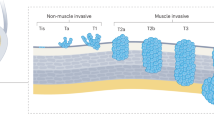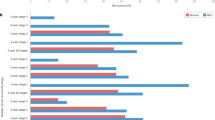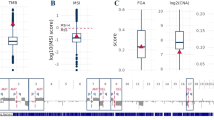Abstract
The diagnosis and follow-up of patients with bladder cancer rely on invasive procedures (cystoscopy with biopsy). Polymerase chain reaction (PCR)-based technologies may allow the sensitive detection of cancer-related genetic mutations in exfoliated tumour material, potentially allowing the development of less invasive techniques. This pilot study investigated the feasibility of detecting mutations in exons 5–8 of the p53 gene using single-stranded conformational polymorphism (SSCP) analysis in bladder-washing specimens from patients with bladder cancer. Bladder-washing samples (31) were collected from patients (27) with bladder cancer. An abnormal additional SSCP band was detected in five samples from five different patients suggesting the presence of a p53 mutation. In all five cases the same abnormal SSCP pattern was demonstrated in samples of the corresponding bladder tumour. In one case bladder washings were available from the same patient on two separate occasions with one washing demonstrating a mutation and the other not. In two further cases a mutation was demonstrated in the bladder tumour but not in the corresponding washing. It is concluded that it is possible to detect and characterize p53 mutations in bladder-washing samples from patients with bladder cancer. Improved sensitivity in detecting mutations in a sample containing a mixture of normal and malignant cells may lead to the clinical applicability of molecular methods of disease monitoring. © 2000 Cancer Research Campaign
Similar content being viewed by others
Article PDF
Change history
16 November 2011
This paper was modified 12 months after initial publication to switch to Creative Commons licence terms, as noted at publication
References
Brown R, Clugston C, Burns P, Edlin A, Vasey P, Vojtesek B and Kaye SB (1993) Increased accumulation of p53 protein in cisplatin-resistant ovarian cell lines. Br J Cancer 55: 678–684
Esrig D, Spruck CH, Nichols PW, Chaiwaun B, Steven K, Groshen S, Chen S-C, Skinner DG, Jones PA and Cote R (1993) p53 nuclear protein accumulation correlates with mutations in the p53 gene, tumour grade and stage in bladder cancer. Am J Pathol 143: 1389–1397
Fitzgerald JM, Ramchurren N, Rieger K, Levesque P, Silverman M, Libertino JA and Summerhayes IC (1995) Identification of H- ras mutations in urine sediments complements cytology in the detection of bladder tumors. J Natl Cancer Inst 87: 129–133
Fujimoto K, Yamada Y, Okajima E, Kakizoe T, Sasaki H, Sugimura T and Terada M (1992) Frequent association of p53 gene mutation in invasive bladder cancer. Cancer Res 52: 1393–1398
Hermansen DK, Reuter VE, Whitmore WF, Fair WR and Melamed MR (1988) Flow cytometry and cytology as response indicators to M-VAC (methotrexate, vinblastine, doxorubicin and cisplatin). J Urol 140: 1394–1396
Levesque P, Ramchurren N, Saini K, Joyce A, Libertino J and Summerhayes IC (1993) Screening of human bladder tumours and urine sediment for the presence of H-ras mutations. Int J Cancer 55: 785–790
Maier U, Simak R and Neuhold N (1995) The clinical value of urinary cytology: 12 years of experience with 615 patients. J Clin Pathol 48: 314–317
Mao L, Schoenberg M, Scicchitano M, Erozan YS, Merlo A, Schwab D and Sidransky D (1996) Molecular detection of primary bladder cancer by microsatellite analysis. Science 271: 659–662
Nigro JM, Baker SJ, Preisinger AC, Jessup JM, Hostetter R, Cleary K, Bigner SH, Davidson N, Baylin S, Devilee P, Glover T, Collins FS, Weston A, Modali R, Harris CC and Vogelstein B (1989) Mutations in the p53 gene occur in diverse human tumour types. Nature 342: 705–708
Orita M, Suzuki Y, Sekiya T and Hayashi K (1989) Rapid and sensitive detection of point mutations and DNA polymorphisms using the polymerase chain reaction. Genomics 5: 874–879
Prosser J, Thompson AM, Granston G and Evans HJ (1990) Evidence that p53 behaves as a tumour suppressor gene in sporadic breast tumours. Oncogene 5: 1573–1579
Phillips HA, Burns D, Prosser J, Howard GCW and Miller WR (1996) The sensitivity of single-stranded conformational polymorphism in mutation detection in a mixed cell population. Br J Cancer 73: 45
Sidransky D, Von Eschenbach A, Tsai YC, Jones P, Summerhayes I, Marshall F, Paul M, Green P, Hamilton SR, Frost P and Vogelstein B (1991) Identification of p53 gene mutations in bladder cancers and urine samples. Science 252: 706–709
Sidransky D, Frost P, Von Eschenbach A, Oyasu R, Preisinger AC and Vogelstein B (1992) Clonal origin of bladder cancer. N Engl J Med 326: 737–740
Sjögren S, Inganas M, Norberg T, Lindgren A, Nordgren H, Holmberg L and Bergh J (1996) The p53 gene in breast cancer: prognostic value of complementary DNA sequencing versus immunohistochemistry. J Natl Cancer Inst 88: 173–182
Smith TA, Whelan J and Parry PJ (1992) Detection of single-base mutations in a mixed population of cells: a comparison of SSCP and direct sequencing. Genet Anal Tech Applicat 9: 143–145
Steiner G, Schoenberg MP, Linn JF, Mao L and Sidransky D (1997) Detection of bladder cancer recurrence by microsatellite analysis of urine. Nat Med 3: 621–624
Vet JA, Witjes JA, Marras SAE, Hessels D, van der Poel HG, Debruyne FMJ and Schalken JA (1996) Predictive value of p53 mutations analyzed in bladder washings for progression of high-risk superficial bladder cancer. Clin Cancer Res 2: 1055–1061
Walther PJ (1992) The role of flow cytometry in the management of bladder cancer. Hematol Oncol Clin North Am 6: 81–98
Winship PR (1989) An improved method for directly sequencing PCR amplified material using dimethyl sulphoxide. Nucleic Acids Res 17: 1266
Wu JK, Ye Z and Darras BT (1993) Sensitivity of single-strand conformation polymorphism (SSCP) analysis in detecting p53 point mutations in tumours with mixed cell populations. Am J Hum Genet 52: 1273–1275
Xu X, Stower MJ, Reid IN, Garner RC and Burns PA (1996) Molecular screening of multifocal transitional cell carcinoma of the bladder using p53 mutations as biomarkers. Clin Cancer Res 2: 1795–1800
Author information
Authors and Affiliations
Rights and permissions
From twelve months after its original publication, this work is licensed under the Creative Commons Attribution-NonCommercial-Share Alike 3.0 Unported License. To view a copy of this license, visit http://creativecommons.org/licenses/by-nc-sa/3.0/
About this article
Cite this article
Phillips, H., Howard, G. & Miller, W. p53 mutations as a marker of malignancy in bladder washing samples from patients with bladder cancer. Br J Cancer 82, 136–141 (2000). https://doi.org/10.1054/bjoc.1999.0890
Received:
Revised:
Accepted:
Published:
Issue date:
DOI: https://doi.org/10.1054/bjoc.1999.0890
Keywords
This article is cited by
-
Diagnostic value of fibronectin and mutant p53 in the urine of patients with bladder cancer: impact on clinicopathological features and disease recurrence
Medical Oncology (2010)
-
P53 mutations in urinary bladder cancer patients from Central Poland
Journal of Applied Genetics (2007)
-
Application of multiplex FISH, CGH and MSSCP techniques for cytogenetic and molecular analysis of transitional cell carcinoma (TCC) cells in voided urine specimens
Journal of Applied Genetics (2006)



